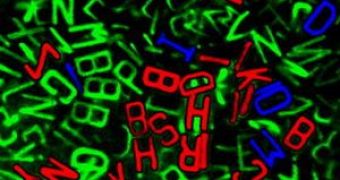An UCLA team has imagined and mass-produced billions of fluorescent microscale polymeric particles in the shapes of all 26 letters of the alphabet in a liquid solution displaying "exquisite fidelity of the shapes".
The "LithoParticles" could have important technological and scientific uses. "We can even choose the font style; if we wanted Times New Roman, we could produce that," said study co-author Thomas G. Mason, a UCLA associate professor of chemistry who holds UCLA's John McTague Career Development Chair.
"We have demonstrated the power of a new method, at the microscale, to create objects of precisely designed shapes that are highly uniform in size," said Mason, a member of UCLA's California NanoSystems Institute. "They are too small to see with the unaided eye, but with an optical microscope, you can see them clearly; the letters stand out in high fidelity. Our approach also works into the nanoscale."
Mason and lead author Carlos J. Hernandez, a UCLA chemistry graduate student, also have made particles with various geometric shapes, like triangles, crosses and doughnuts, even three-dimensional "Janus particles" with two differently shaped faces. "We have made fluorescent lithographic particles, we have made complex three-dimensional shapes and, as shown by UCLA postdoctoral fellow Kun Zhao, we can assemble these particles, for example, in a lock-and-key relationship," said Mason.
"We can mass-produce complex parts having different controlled shapes at a scale much smaller than scientists have been able to produce previously. We have a high degree of control over the parts that we make and are on the verge of making functional devices in solution. We may later be able to configure the parts into more complex and useful assemblies."
"Can we cause the components to fit together in a controlled way that may be useful to us? Can we create useful complex structures out of fundamental parts, in solution, where we can mass-produce a small-scale engine, for example? We will pursue these research questions."
As the letters are smaller than many kinds of cells, they could be used to mark individual cells. "It may be possible to use a molecule to attach a letter to a cell's surface or perhaps even insert a letter inside a cell and use the letter-marker to identify the cell", Mason said.
The method could be also employed to build tiny pumps, motors or containers for medical or security applications. "We have used 'laser tweezers' to pick up the jumbled letters 'U, C, L, A' and move them together in order, like skywriting in solution," Mason said. "UCLA's Office of Intellectual Property has applied for patent protection on this platform technology and is beginning to speak with potential corporate partners to bring new products to market based on this technology to benefit the public good," said Earl Weinstein, chief of technology business development and licensing for UCLA's technology transfer office.

 14 DAY TRIAL //
14 DAY TRIAL //